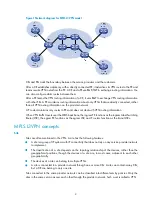
7
•
EBGP
This section briefly introduces the cooperation of routing protocols and MCE. For information about the
routing protocols, see
Layer 3—IP Routing Configuration Guide
.
Static routes
An MCE can communicate with a site through static routes. As static routes configured for traditional CEs
take effect globally, address overlapping between multiple VPNs remains a problem until the emergence
of MCE. MCE allows static-route-to-VPN-instance binding, which isolates the static routes of different
VPNs.
RIP
The switch can bind RIP processes to VPN instances. With these bindings on the MCE, private network
routes of different VPNs can be exchanged between MCE and sites through different RIP processes,
isolating and securing VPN routes.
OSPF
The switch can bind OSPF processes to VPN instances and isolate the routes of different VPNs.
For an OSPF process bound to a VPN instance, the router ID of the public network configured in system
view is invalid. You must specify the router ID when creating an OSPF process.
An OSPF process can be bound to only one VPN instance. However, a VPN instance can use multiple
OSPF processes for private network route transmission. To make sure routes can be advertised properly,
configure the same domain ID for all OSPF processes bound to the same VPN instance.
Routes redistributed from OSPF to BGP on the MCE have their OSPF attributes removed. To enable BGP
to distinguish routes redistributed from different OSPF domains, you must enable the redistributed routes
to carry the OSPF domain ID by configuring the
domain-id
command in OSPF view. The domain ID is
added to BGP VPN routes as an extended community attribute.
In cases where a VPN has multiple MCE devices attached to it and when an MCE device advertises the
routes learned from BGP within the VPN, the routes may be learned by other MCE devices, generating
route loops. To prevent route loops, configure route tags for different VPN instances on each MCE. H3C
recommends that you assign the same route tag to the same VPN on all MCEs.
IS-IS
Similar to those in OSPF, IS-IS processes can be bound to VPN instances for private network routes to be
exchanged between MCE and sites. An IS-IS process can be bound to only one VPN instance.
IBGP
To use IBGP to exchange private routes between an MCE and a site, configure IBGP peers for VPN
instances on the MCE and redistribute IGP routing information from corresponding VPNs. If the MCE is
connected with multiple sites in the same VPN, you can configure the MCE as a route reflector (RR) and
configure the egress routers of the sites as clients, making the MCE reflect routing information between
the sites. This eliminates the necessity for BGP connections between sites, reducing the number of BGP
connections and simplifying network configuration.
EBGP
To use EBGP for exchanging routing information between an MCE and VPN sites, you must configure a
BGP peer for each VPN instance on the MCE, and redistribute the IGP routes of each VPN instance on
the VPN sites. You also can configure filtering policies to filter the received routes and the routes to be
advertised.
















































